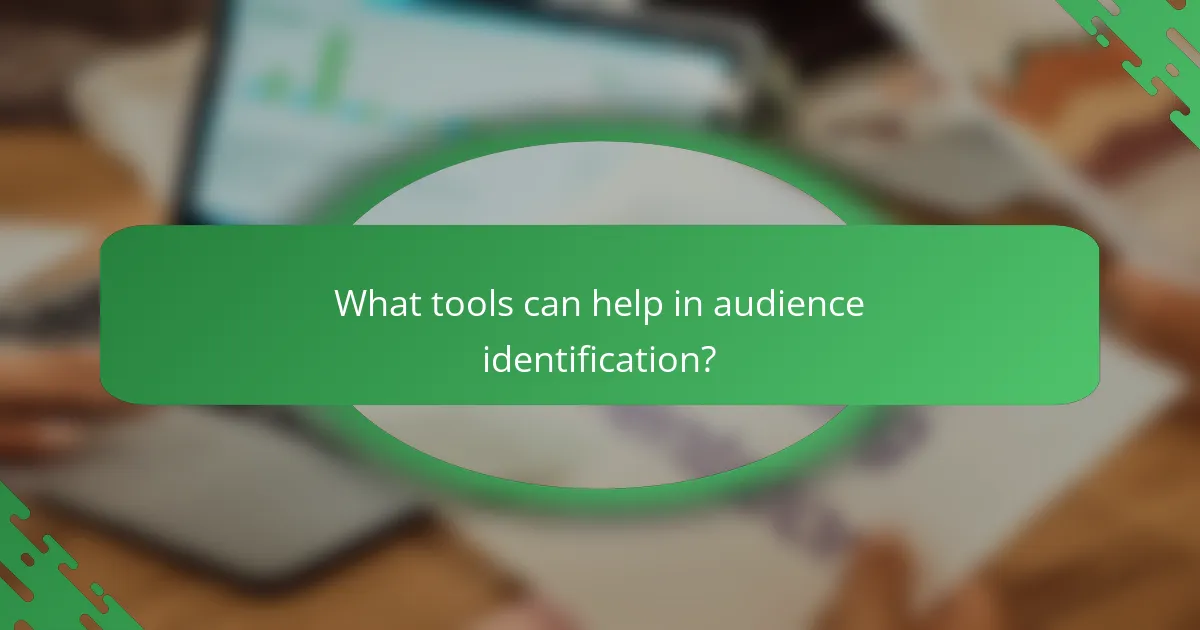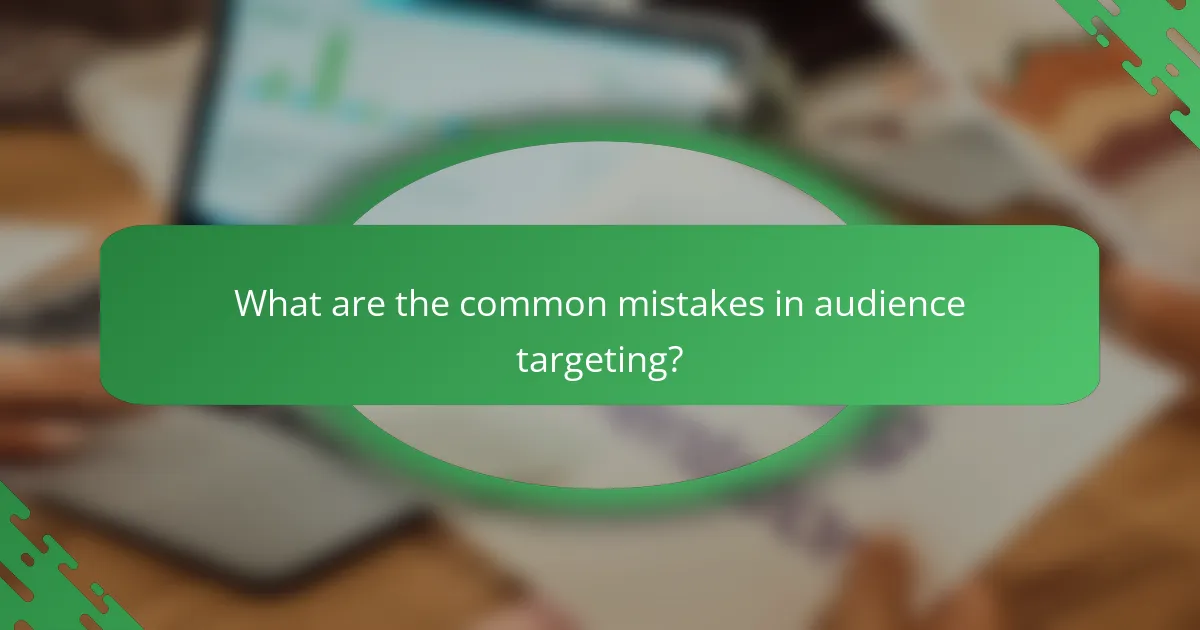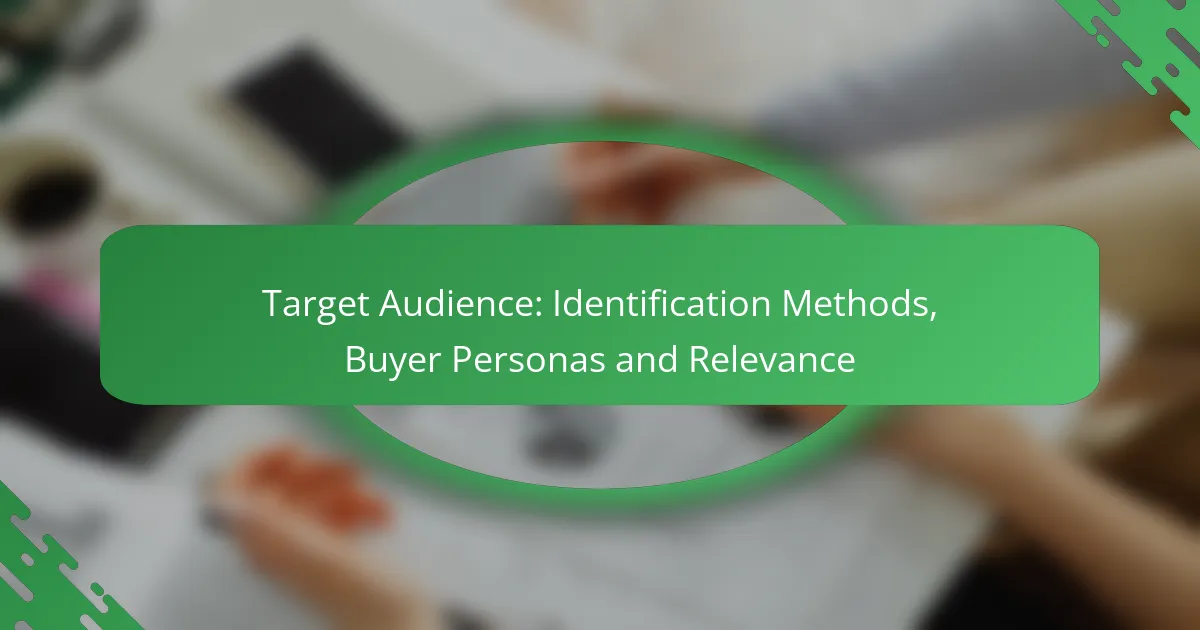Identifying your target audience is crucial for effective marketing, as it allows businesses to understand the needs and preferences of potential customers. Utilizing methods such as market research and social media insights can help create detailed buyer personas, which are essential for tailoring marketing strategies and enhancing product development. By focusing on demographics, behaviors, and the customer journey, businesses can ensure their messaging resonates with their audience, ultimately driving engagement and sales.

How to identify target audience in the UK?
Identifying your target audience in the UK involves understanding who your potential customers are and what they need. This process can be achieved through various methods, including market research, social media insights, customer feedback, and website analytics.
Market research surveys
Market research surveys are a direct way to gather information about your target audience’s preferences and behaviors. These surveys can be distributed online or offline and should include questions that help identify demographics, interests, and purchasing habits.
When designing surveys, keep them concise and focused. Aim for a completion time of under 10 minutes to encourage participation. Offering incentives, such as discounts or entries into a prize draw, can also boost response rates.
Social media analytics
Social media analytics tools provide valuable insights into your audience’s demographics and engagement patterns. Platforms like Facebook, Instagram, and Twitter offer built-in analytics that can help you understand who interacts with your content and how.
Monitor metrics such as age, location, and interests to tailor your marketing strategies. Regularly reviewing these analytics can help you adjust your content to better resonate with your audience and enhance engagement.
Customer feedback analysis
Analyzing customer feedback is crucial for understanding your audience’s needs and preferences. This can be done through reviews, testimonials, and direct feedback collected via email or customer service interactions.
Look for common themes in the feedback to identify areas for improvement or new opportunities. Implementing changes based on customer suggestions can lead to increased satisfaction and loyalty.
Website traffic analysis
Website traffic analysis helps you understand who visits your site and how they interact with your content. Tools like Google Analytics can provide insights into visitor demographics, behavior, and conversion rates.
Pay attention to metrics such as bounce rate and average session duration to gauge user engagement. Use this data to optimize your website’s content and layout, ensuring it meets the needs of your target audience effectively.

What are buyer personas and their importance?
Buyer personas are semi-fictional representations of your ideal customers based on market research and real data about existing customers. They help businesses understand their audience better, enabling more effective marketing strategies and product development.
Definition of buyer personas
Buyer personas are detailed profiles that outline the characteristics, behaviors, motivations, and challenges of specific segments of your target audience. These personas are created by analyzing data from customer interactions, surveys, and interviews, providing insights into who your customers are and what they need.
Typically, a buyer persona includes demographic information, such as age, gender, and income level, as well as psychographic details like interests, values, and buying habits. This comprehensive view allows businesses to tailor their messaging and offerings to resonate with their audience.
Benefits of using buyer personas
Utilizing buyer personas offers several advantages, including improved marketing effectiveness and enhanced customer engagement. By understanding the specific needs and pain points of different personas, businesses can create targeted campaigns that speak directly to those concerns, leading to higher conversion rates.
Additionally, buyer personas facilitate better product development by ensuring that offerings align with customer expectations. They serve as a guide for content creation, helping teams produce relevant materials that attract and retain customers. Overall, leveraging buyer personas can lead to increased customer loyalty and long-term business success.

How to create effective buyer personas?
Creating effective buyer personas involves gathering detailed insights about your target audience to tailor your marketing strategies. This process includes understanding demographics, behaviors, and the customer journey to ensure your messaging resonates with potential buyers.
Demographic profiling
Demographic profiling focuses on the statistical characteristics of your target audience, such as age, gender, income, education, and location. These factors help you identify who your customers are and segment them into distinct groups for targeted marketing.
For example, a company selling luxury goods may target high-income individuals aged 30-50 in urban areas. Understanding these demographics allows for more personalized advertising and product offerings.
When creating demographic profiles, consider using surveys, social media analytics, and customer databases to gather relevant data. Avoid relying solely on assumptions; data-driven insights yield more accurate personas.
Behavioral segmentation
Behavioral segmentation categorizes your audience based on their interactions with your brand, including purchasing habits, product usage, and engagement levels. This approach helps identify patterns that can inform marketing strategies and product development.
For instance, you might segment customers into categories such as frequent buyers, occasional shoppers, and one-time visitors. By understanding these behaviors, you can tailor your messaging to encourage repeat purchases or re-engage lapsed customers.
Utilize analytics tools to track customer behavior on your website and social media platforms. This data can reveal insights into customer preferences and help you refine your marketing efforts effectively.
Customer journey mapping
Customer journey mapping visualizes the steps a customer takes from awareness to purchase and beyond. This process highlights key touchpoints and interactions, allowing you to understand how customers experience your brand.
For example, a customer may first encounter your brand through social media, then visit your website, and finally make a purchase. Mapping these stages helps identify potential pain points and opportunities for improvement in the customer experience.
To create an effective customer journey map, gather feedback from customers through interviews or surveys. This information can guide your marketing strategies and enhance customer satisfaction by addressing their needs at each stage of the journey.

What tools can help in audience identification?
Several tools can assist in audience identification by providing insights into user behavior, demographics, and preferences. Utilizing these tools effectively can enhance your marketing strategies and improve engagement with your target audience.
Google Analytics
Google Analytics is a powerful tool that tracks website traffic and user behavior. It provides data on demographics, interests, and user engagement, allowing businesses to understand who their audience is and how they interact with content.
To get started, set up tracking on your website and explore the Audience section to view insights. Pay attention to metrics like bounce rate and session duration, which can indicate how well your content resonates with visitors.
HubSpot
HubSpot offers a comprehensive suite of marketing tools that includes audience identification features. It allows you to create detailed buyer personas based on data collected from forms, surveys, and user interactions.
Utilize HubSpot’s persona tool to segment your audience effectively. This can help tailor your marketing efforts to specific groups, ensuring that your messaging aligns with their needs and preferences.
SEMrush
SEMrush is primarily known for its SEO capabilities, but it also provides valuable insights into audience identification. Its tools can analyze competitors and identify target demographics based on keyword research and traffic sources.
Use SEMrush to conduct market research and discover which audience segments are engaging with similar brands. This can guide your content strategy and help you position your offerings more effectively in the market.

How to evaluate audience relevance?
Evaluating audience relevance involves assessing how well your target audience aligns with your product or service. This can be done through various metrics that indicate engagement, conversion, and overall value derived from customers.
Engagement metrics
Engagement metrics measure how actively your audience interacts with your content or brand. Key indicators include likes, shares, comments, and time spent on your website. High engagement typically suggests that your audience finds your content relevant and valuable.
To evaluate engagement, consider using tools like Google Analytics to track user behavior. Look for patterns such as peak interaction times or popular content types, which can guide your marketing strategies.
Conversion rates
Conversion rates indicate the percentage of visitors who take a desired action, such as making a purchase or signing up for a newsletter. A higher conversion rate signifies that your audience is not only engaged but also relevant to your business goals.
To improve conversion rates, focus on optimizing your landing pages and calls to action. A/B testing different approaches can help identify what resonates best with your audience, leading to increased conversions.
Customer lifetime value
Customer lifetime value (CLV) estimates the total revenue a business can expect from a single customer over their entire relationship. Understanding CLV helps in determining how much you can invest in acquiring new customers while maintaining profitability.
To calculate CLV, consider factors like average purchase value, purchase frequency, and customer retention rate. A higher CLV indicates that your audience is not only relevant but also loyal, making them a valuable asset for your business.

What are the common mistakes in audience targeting?
Common mistakes in audience targeting include neglecting data analysis, relying solely on assumptions, and failing to refine buyer personas. These errors can lead to ineffective marketing strategies and wasted resources.
Ignoring data analysis
Ignoring data analysis can severely hinder effective audience targeting. Without analyzing existing data, businesses miss valuable insights about customer behavior, preferences, and demographics, which are crucial for tailoring marketing efforts.
To avoid this mistake, regularly collect and review data from various sources, such as website analytics, social media engagement, and customer feedback. This information can help identify trends and patterns that inform your targeting strategy.
For example, if data shows that a significant portion of your audience engages with content during specific hours, you can optimize your posting schedule to maximize visibility. Additionally, consider using tools like Google Analytics or social media insights to streamline data collection and analysis.
